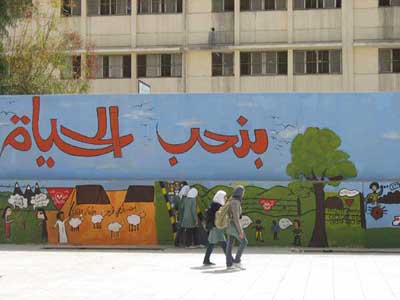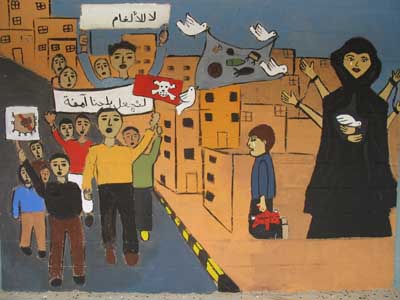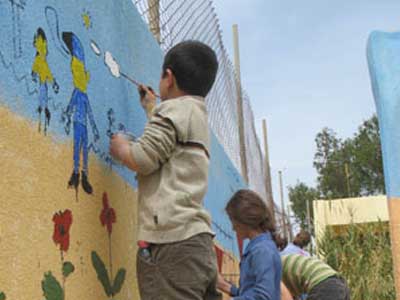Anne Stewart Feature
Anne Stewart, a psychology professor at James Madison University, received an invitation to attend a meeting with other faculty from the Center for International Stabilization and Recovery in the mid-1990s, as the center was being established.
She said that meeting was transformational. It helped to spur several years of landmine recovery work for Stewart, in multiple countries.
“It was like, 'Okay, I gotta be here,'” Stewart said. “It seemed [an] incredibly relevant and compelling, meaningful spot to be."
In 1996, Stewart took on her first initiative, in Cambodia, to create various materials that could be distributed to help create awareness about the prevalence of injuries due to landmines, and their effects on children.
Stewart found out that there was a low level of literacy in the country, so she worked with JMU’s art department to create graphic renderings on cards that could be understood visually. Some of the cards had words and statements like “hyperactivity,” “bothered by worries” and “What can you do to help?”
“So, remind them [victims of landmines] that the actions are normal and that they’ll change over time,” Stewart said.
Other cards followed included guidance on how to stay safe from landmines, like “don’t touch.” Then some cards depicted a dog as a landmine survivor. The dog had super powers and could help children to play safe.
"I looked into what could be a graphic that might be enticing to kids,” Stewart said. “And I tried to find some stories that were related to culture. I was surprised I didn't think about dogs, but dogs have a place where they're recognized in the society a variety of different ways."
In addition to the cards, a coloring book was made that showed how an incident could happen.
Two major theories were behind the development of these materials: attachment theory and resilience.
In November 1997, Stewart was able to make a trip to Bosnia, where she developed a model for landmine awareness.
"What I proposed is that they needed to integrate education, clearance and recovery ,” Stewart said. “Still hadn’t happened, but I think it’s a good model.”
Stewart’s work continued in the Vietnam from 1998-2001.
“One of the biggest issues, and a personal challenge, was figuring out if I could do this with any authenticity,’ Stewart said. “Especially when it came to Vietnam. These were bombs that we dropped on Vietnam. And they're still there. So why would they care what some white woman from a university comes and tells them that these are a problem when her country is the one that dropped them?”
The work in Vietnam was centered on humanitarian education to reduce the risk of mines, specifically around children in Quang Tri Province. A landmine education center was established, and products such as games were made to teach children about landmines.
There was also a data collection effort for which partnerships were made with existing organizations like the Vietnam Women’s Union and the Vietnam Committee for the Protection and Care of Children. Also the Communist Party, which provided permission for the initiative.
"Incredibly, incredibly thoughtful, reflective, easy to work with about their children,” Stewart said of the Communist Party. “They wanted a safer future for their kids."
Another way landmine education was spread in Vietnam was through an art project. Students from various provinces created thousands of art pieces for a competition. Over 30 local artists were brought in to judge, and the winning entries were made into calendars, booklets and posters.
The work continued in Jordan not long after Ken Rutherford took over as the director of CISR in 2010. There they partnered with a landmine survivor who wanted to start an NGO focusing on landmine education.
"We wanted to do it through expressive arts — drawings, murals,” Stewart said.
CISR also worked alongside the National Demining Center for Jordan. It found that people were most often getting hurt in areas that they were unfamiliar with, as they didn’t know the safe paths or which spots to avoid.
According data from Landmine and Cluster Munition Monitor, male civilians suffered the most casualties due to landmines in 2009.
According to data from Landmine and Cluster Munition Monitor, landmines killed more civilians than military personnel in 2009.
In 2009, landmines injured more civilians than military personnel in most landmine-affected countries. However, in countries such as Colombia and Myanmar, military personnel suffered more landmine-related injuries. This data was recovered from Landmine and Cluster Munition Monitor.
According to 2009 data from Landmine and Cluster Munition Monitor, civilian men and boys are most affected by landmine-related injuries. In some countries such as Afghanistan, Chad, Somalia, Sudan and Yemen, landmines injure more boys than men.
In keeping with the ideals of play therapy, it was decided that a play would be a fun but effective way to get the messages of safety across. A local playwright was commissioned, and he called his work “The Ghosts of the Valley.”
The children did not react well.
“The kids watching got scared to pieces, there [were bombs] frightening them, and there was someone with disabilities, and they were scared of him,” Stewart said.
She then incorporated her idea of positivity and play into the show to make it more accessible to the children, not just shocking. After renaming it “We Love Life,” songs were written into this version of the play, and instead of focusing entirely on fear, the focus shifted to the aspects of community and caring for one another.
“We Love Life” was shown to over 16,000 kids. Research shows that it’s had a very positive effect on the community, with a positive impact on knowledge, attitudes and behavior. The most powerful impact, however, was on the children’s views of disabilities.
“In the play, we just had people mixed in, people with disabilities, people who lost sight, people who didn’t have hands, people who’ve lost limbs, and we didn’t say anything about that, and at the end of the play, they each told their story,” Stewart said.
That play is now being shown at some of the Syrian camps to help people there as well. However, Stewart said her proudest moment after the play actually happened in a meeting with CISR and the National Demining Center of Jordan, where a board member told her that after seeing “We Love Life,” and seeing the children’s reactions to the disabled, he went to town and bought himself five short-sleeve shirts. He hadn’t worn short sleeves since a landmine accident cost him both his arms, but then knew that others would accept him.
Stewart constantly talks about the idea that love and supportiveness are much more effective than any fear tactic, and that is reflected in the exercises that she had the children participate in. One of her favorites was simple — bounce a rubber ball to one another, saying what helped each individual bounce back from hard times themselves. One of her fondest memories occurred while playing this game.
“So we’ve got all these bouncy balls, we’re down in this oppressive basement, and all of a sudden they were like, ‘We have to get out of here, can we go outside?’ and we were like, ‘Yeah, but why?’ and they said, ‘The ceiling's too low, it limits how far I bounce back, I bounce way, way higher than this ceiling is!’ So we went outside and sent them to the sky,” Stewart said.
When looking at her credentials, it seems like Stewart has an interest in everything, from psychology to play therapy, from teaching to activism. She said that they all come from the same place, a place that wants the world to be safe for everyone. Being involved with CISR has given her a chance to speak to both physical and emotional safety.
“I think it needs more attention … the more integrated programs are, you are able to address education as you’re clearing [landmines],” Stewart said. “The acute treatment of people is one phase of the victim assistance, the re-integration is another long term area to focus on … Even if we got everything clear, if persons who have survived injuries are marginalized and disenfranchised from their communities, then we just still have a lot of important work to do … We need to partner up and make the world safer for everybody.”








